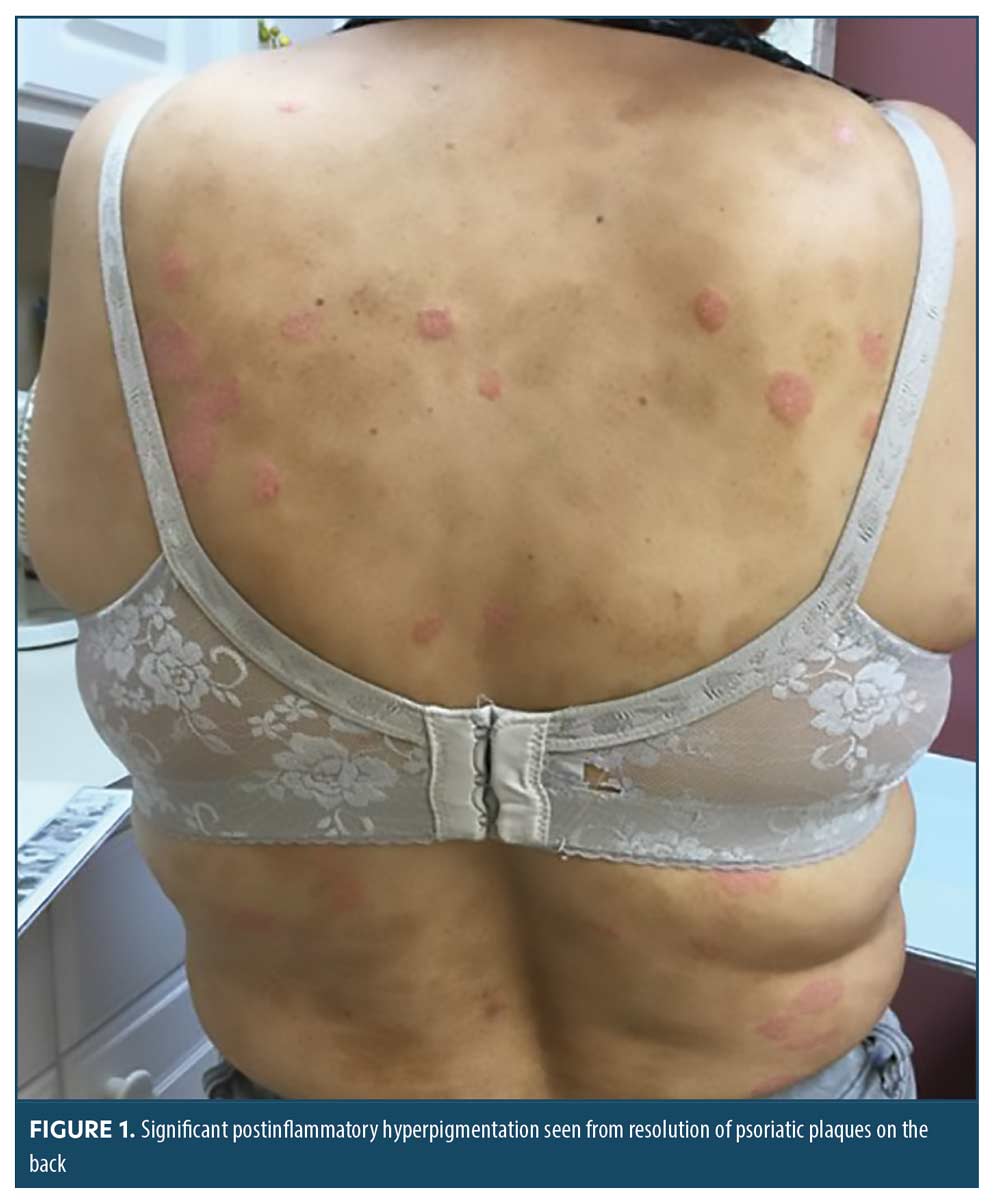 J Clin Aesthet Dermatol. 2021;14(12 Suppl 1):S24–S25
J Clin Aesthet Dermatol. 2021;14(12 Suppl 1):S24–S25
by Archana M. Sangha, MMS, PA-C
Ms. Sangha is a medical science liaison for Incyte in Wilmington, Delaware. Prior to that, she spent over a decade as a dermatology PA specializing in general, surgical, and cosmetic dermatology. She is a fellow of the American Academy of Physician Assistants in Alexandria, Virginia. She is also Immediate Past President of the Society of Dermatology Physician Assistants.
FUNDING: No funding was provided for this article.
DISCLOSURES: Ms. Sangha is an employee of Incyte in Wilmington, Delaware.
A population study in the United States (US) found the incidence of psoriasis to be 3.6 percent in white skin, 1.9 percent in African Americans, 1.6 percent in Hispanics, and 1.4 percent in other racial groups.1 Psoriasis is a chronic, inflammatory skin disorder often characterized by red, scaly plaques. However, psoriasis in skin of color (SOC) populations often differs from this presentation, and is one reason that psoriasis may be underdiagnosed in these populations.2 This article will highlight a few clinical nuances to consider when treating psoriasis in skin of color patients.
Clinical Clues for Diagnosing Psoriasis in Skin of Color
Recognizing inflammation in darker skin is more difficult—erythema often appears violaceous, dark brown, or gray in SOC patients—and this may be one reason psoriatic disease severity is minimized in this patient population. Resolving psoriatic lesions often leave patients with hyper- or hypopigmentation. The differential diagnosis often includes cutaneous lupus erythematosus, hypertrophic lichen planus, cutaneous T-cell lymphoma, and sarcoidosis.2 Arriving at an accurate diagnosis involves a thorough patient history and examination of the skin. Special attention should be given to lesion morphology, distribution, and duration.
Plaque psoriasis is the most common type of psoriasis seen among all races. However, a recent cross-sectional study found that some types of psoriasis have a predilection for certain races. For example, pustular psoriasis is more likely to be seen in Asian and Hispanic populations. Asian populations are also more likely to present with erythrodermic psoriasis and less likely to have inverse psoriasis.3 One study found that Asian and Hispanic populations are more likely to present with greater disease severity than Caucasian patients.4 East Asian patients often have smaller, less widespread plaques than Caucasian patients.5 Asian and Black patients are also more likely to present with scalp psoriasis.6
Cultural Competence
When recommending treatment options for scalp psoriasis in SOC patients, it’s important to ask about their hair care practices. If a patient washes their hair once a week, as is common in African-American populations, it would be impractical to recommend a regimen that involves shampooing the hair daily. Instead, consider foams and oil-based solutions that can be left on the scalp. 2
Addressing Pigmentary Alterations
SOC patients are often just as bothered by the post-inflammatory pigmentary changes as they are by the active psoriatic plaques (Figure 1). It’s important to counsel patients on what to expect when psoriatic plaques begin to improve and to also have a plan to treat the post-inflammatory pigmentary changes. For example, it may be prudent to consider tazoretene as a treatment option for patients with active psoriasis and post-inflammatory hyperpigmentation as it is effective in treating both.7 This propensity for hyperpigmentation should also inform clinician recommendations for phototherapy in darker skin types. Phototherapy can be an effective modality, but consideration should be given to strength of therapy, and patients should be properly counseled about the risk of hyperpigmentation prior to treatment.8

Unfamiliarity with Biologics Among Black Patients
Systemic therapy is the mainstay of treatment for patients with moderate-to-severe psoriasis. In the long-term treatment of psoriasis, biologics have better tolerability and safety than other systemic agents, such as methotrexate, and cyclosporine.9 However, one study found that Black patients were 69-percent less likely than White patients to receive biologic therapy.10 A recent follow-up study compared perceptions about biologics and other psoriasis treatment options among Black and White patients. Among biologic-naïve patients, both groups listed “apprehension”, “side effects” and “immune suppression” in response to injectable biologics. Only Black biologic-naïve patients listed “unfamiliar” and “dislike needles” when asked to describe self-injectable biologics.11 In addition, research has shown that the quality of life in African American and Hispanic patients is more negatively impacted than in Caucasian patients, irrespective of psoriasis disease severity.12 These findings further underscore the need to thoroughly educate all patients on all appropriate treatment options.
References
- Rachakonda TD, Schupp CW, Armstrong AW. Psoriasis prevalence among adults in the United States. J Am Acad Dermatol. 2014;70(3):512–516.
- Alexis AF, Blackcloud P. Psoriasis in skin of color: epidemiology, genetics, clinical presentation, and treatment nuances. J Clin Aesthet Dermatol. 2014;7(11):16–24.
- Yan D, Afifi L, Jeon C, et al. A cross-sectional study of the distribution of psoriasis subtypes in different ethno-racial groups. Dermatol Online J. 2018;24.
- Abrouk M, Lee K, Brodsky M, et al. Ethnicity affects the presenting severity of psoriasis. J Am Acad Dermatol. 2017;77(1):180–182.
- Kim J, Oh CH, Jeon J, et al. Molecular phenotyping small (Asian) versus large (Western) plaque psoriasis shows common activation of IL-17 pathway genes but different regulatory gene sets. J Invest Dermatol. 2016;136(1):161–172.
- Kaufman BP, Alexis AF. Psoriasis in skin of color: insights into the epidemiology, clinical presentation, genetics, quality-of-life impact, and treatment of psoriasis in non-white racial/ethnic groups. Am J Clin Dermatol. 2018;19:
405–423. - Grimes P, Callender V. Tazarotene cream for postinflammatory hyperpigmentation and acne vulgaris in darker skin: a double-blind, randomized, vehicle-controlled study. Cutis. 2006;77(1):45–50.
- Youssef RM, Mahgoub D, Mashaly HM, et al. Different narrowband UVB dosage regimens in dark skinned psoriatics: a preliminary study. Photodermatol Photoimmunol Photomed. 2008;24:256–259.
- Gisondi P, Del Giglio M, Girolomoni G. Treatment approaches to moderate to severe psoriasis. Int J Mol Sci. 2017;18(11):2427.
- Takeshita J, Gelfand JM, Li P, et al. Psoriasis in the US Medicare population: prevalence, treatment, and factors associated with biologic use. J Invest Dermatol. 2015;135(12):2955–2963.
- Takeshita J, Eriksen WT, Raziano VT, et al. Racial differences in perceptions of psoriasis therapies: implications for racial disparities in psoriasis treatment. J Invest Dermatol. 2019;139(8):
1672–1679. - Shah SK, Arthur A, Yang YC, et al. A retrospective study to investigate racial and ethnic variations in the treatment of psoriasis with etanercept. J Drugs Dermatol. 2011;10(8):866–872.

